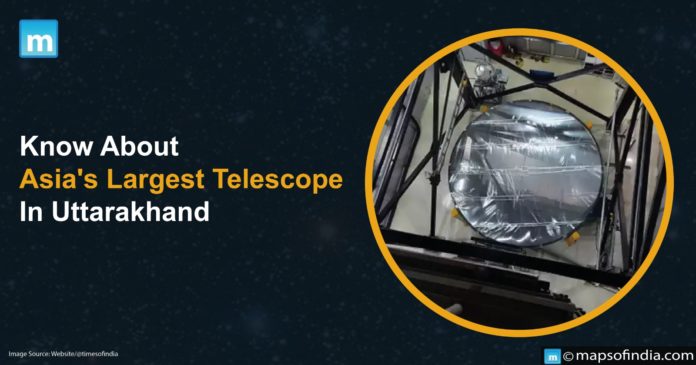The 4-meter International Liquid Mirror Telescope (ILMT), the largest in Asia, was unveiled on Tuesday, March 21st, 2023, at Devasthal in Uttarakhand, marking another scientific achievement for India.
Asia’s Largest 4-meter International Liquid Mirror Telescope
The world-class 4-meter International Liquid Mirror Telescope (ILMT), developed by the Aryabhatta Research Institute of Observational Sciences (ARIES), has been made ready to study the deep, celestial sky, according to an announcement. During the second week of May 2022, it got its first light. The telescope is located at the Devasthal Observatory campus of ARIES, an independent organization run by the Department of Science and Technology (DST), Government of India, in the Nainital district of Uttarakhand, at the height of 2450 meters.
The light collection and focusing mechanism of the ILMT is a rotating mirror with a diameter of 4 meters, coated with a thin layer of liquid mercury. Mercury is ideally suited to create this kind of mirror because it is both liquid at room temperature and highly reflective. Supernovae, gravitational lenses, asteroids, and other transient or variable celestial objects can all be found using the ILMT, which is built to scan the strip of sky passing over your head every night.
Every night, the telescope will produce close to 10-15 gigabytes of data while scanning the strip of the sky, and the abundance of ILMT-generated data will enable the application of big data and artificial intelligence/machine learning (AI/ML) algorithms that will be put in effect for classifying the objects observed with it.
According to the DST, a deep photometric and astrometric variability survey can be carried out using the information gathered from the ILMT over its five-year operational period. The data will also be swiftly analyzed to find and distinguish variable, transient stellar sources. With the help of sophisticated back-end instruments, the 3.6-meter telescope will enable quick follow-up observations of the recently discovered transient sources.
Union Minister Dr Jitendra Singh’s Remarks
In the presence of the Governor of Uttarakhand, Lt. Gen. (Retd.) Gurmeet Singh, Dr Jitendra Singh, the Union Minister of State (Independent Charge) for Science and Technology, Minister of State (Independent Charge) for Earth Sciences, and Minister of State (Independent Charge) for Personnel, Public Grievances, Pensions, Atomic Energy, and Space, unveiled the largest 4-meter International Liquid Mirror Telescope in Asia.
Jitendra Singh, the minister of state for science, technology, and space, claimed that the ILMT is the first liquid mirror telescope created specifically for astronomical observations. In addition to being India’s first optical survey telescope, it has the largest aperture currently available in the nation. According to Dr Jitendra Singh, the ILMT collaboration includes scientists worldwide.
Belgium’s Centre Spatial de Liège and the Advanced Mechanical and Optical Systems (AMOS) Corporation collaborated to design and construct the telescope. The telescope has brought a proud moment among Indians. It will be used to detect more supernovae, gravitational lenses, space debris, and asteroids which are examples of transient or variable celestial objects. It will initiate the advancement of science around the world.





